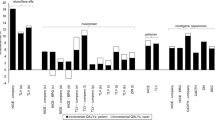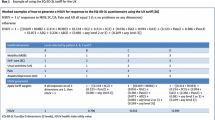Summary
Decisions about medical treatment and health programmes involve both technical and value judgements. For the purpose of performing an economic appraisal of different health interventions (including drug interventions), a single global score is essential as the measure of outcome. This measure should enable us to compare different interventions that affect both duration and quality of life at different levels of effect. This article provides a short but critical overview of the most commonly used measure of outcome in such cases — the quality adjusted life years (QALY). We describe the measure and discuss its limitations. More specifically we discuss problems stemming from the fact that QALYs do not fully reflect individual preferences and the fact that different (not necessarily comparable) methods of measurement can be used to generate the weights. We also discuss the issue of the equity implications of the methods used to aggregate the QALY values of individuals to arrive at a community health outcome measure. Our conclusion is that the use of QALY does not coincide with achieving the stated goal of economic evaluations (i.e. efficient allocation of resources to enable maximisation of the health of the community for any given level of resources). An alternative measure of outcome — the healthy years equivalent (HYE), which does not suffer from many of the major limitations associated with the QALY measure — is described and discussed.
Similar content being viewed by others
References
Ben-Zion U, Gafni A. Evaluation of public investment in health care: is the risk irrelevant? Journal of Health Economics 2: 161–165, 1983
Drummond MF, Stoddart GL, Torrance GW. Methods of economic evaluation of health care programmes. Oxford Medical Publications, Oxford University Press, Oxford, 1987
Dyer JS, Savin RK. Group preference aggregation rules based on strength of preferences. Management Science 25: 822–832, 1979
Eisenberg JM. Clinical economics: a guide to the economic analysis of clinical practices. Journal of the American Medical Association 262: 2879–2886, 1989
Eliashberg J, Winkler RL. A methodology for group decision making. Management Science 27: 1221–1235, 1981
EuroQol Group. EuroQol — a new facility for the measurement of health related quality of life. Health Policy 16: 199–208, 1990
Fleming M. A cardinal concept of welfare. Quarterly Journal of Economics 66: 366–384, 1952
Froberg DG, Kane RL. Methodology for measuring health-state preferences I–IV: measurement strategy, scaling methods, population and context effects, progress and research agenda. Journal of Clinical Epidemiology 4: 345–354, 459–471, 585–592, 675–685, 1989
Gafni A. The quality of QALYs: do QALYs measure what they at least intend to measure? Health Policy 13: 81–83, 1989
Gafni A. Considerations of the measures useful for quantifying adverse effects of unnecessary hypertension drug therapy. Clinical and Investigative Medicine 14: 266–270, 1991a
Gafni A. Using willingness-to-pay as a measure of benefits: what is the relevant question to ask in the context of public decision-making about health care problems. Medical Care 29: 1246–1252, 1991b
Gafni A, Birch S. Equity considerations in utility-based measures of health outcomes in economic appraisals: an adjustment algorithm. Journal of Health Economics 10: 329–342, 1991
Gafni A, Zylak CJ. Ionic versus nonionic contrast media: a burden or bargain? Canadian Medical Association Journal 143: 475–478, 1990
Goel V, Deber RB, Detsky AS. Nonionic contrast media: economic analysis and health care policy development. Canadian Medical Association Journal 140: 389–395, 1989
Harsanyi JC. Cardinal, welfare, individualistic ethics and interpersonal comparisons of utility. Journal of Political Economy 63: 309–321, 1955
Keeney RL. A group preference axiomatization with cardinal utility. Management Science 23: 140–145, 1976
Keeney RL, Kirkwood CK. Group decision making using cardinal social welfare function. Management Science 22: 430–437, 1975
Loomes G, McKenzie L. The use of QALYs in health care decision making. Social Science and Medicine 28: 299–308, 1989
McNeil BJ, Weichselbaum R, Pauker SG. Fallacy of five-year survival in living cancer. New England Journal of Medicine 299: 1397–1401, 1978
Mehrez A, Gafni A. The optimal treatment strategy — a patient perspective. Management Science 33: 1602–1612, 1987
Mehrez A, Gafni A. Quality adjusted life years, utility theory, and healthy years equivalents. Medical Decision Making 9: 142–149, 1989
Mehrez A, Gafni A. Evaluating health related quality of life: an indifference curve interpretation for the time trade-off technique. Social Science and Medicine 31: 1281–1283, 1990
Mehrez A, Gafni A. Healthy years equivalent: how to measure them using the standard gamble approach. Medical Decision Making 11: 140–146, 1991
Pliskin JS, Shepard DS, Weinstein MC. Utility functions for life-years and health status. Operations Research 28: 206–224, 1980
Read JL, Quinn RJ, Berwick DM, Finberg HV, Weinstein MC. Preference for health outcomes: comparison of assessment methods. Medical Decision Making 4: 315–329, 1984
Shepard DS, Thompson MS. First principles of cost-effectiveness analysis in health. Public Health Reports 94: 535–543, 1979
Torrance GW. Utility approach to measuring health related quality of life. Journal of Chronic Disease 40: 593–600, 1987
Torrance GW. Measuring of health state utilities for economic appraisal: a review. Journal of Health Economics 5: 1–30, 1986
Wagstaff A. QALYs and the equity-efficiency trade-off. Journal of Health Economics 10: 21–41, 1991
Weinstein MC, Fineberg HC, Elstein AS, Fragier HS, Neuhauser D, et al. Clinical decision analysis, W.B. Saunders, Philadelphia, 1980
Weinstein MC, Stason WB. Foundations of cost-effectiveness analysis for health and medical practices. New England Journal of Medicine 296: 716–721, 1977
Williams A. Economics of coronary artery bypass grafting. British Medical Journal 291: 326–329, 1985
Author information
Authors and Affiliations
Rights and permissions
About this article
Cite this article
Mehrez, A., Gafni, A. Preference Based Outcome Measures for Economic Evaluation of Drug Interventions. Pharmacoeconomics 1, 338–345 (1992). https://doi.org/10.2165/00019053-199201050-00005
Published:
Issue Date:
DOI: https://doi.org/10.2165/00019053-199201050-00005




